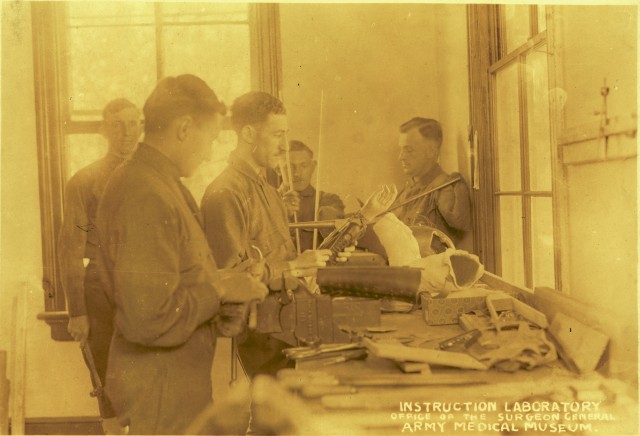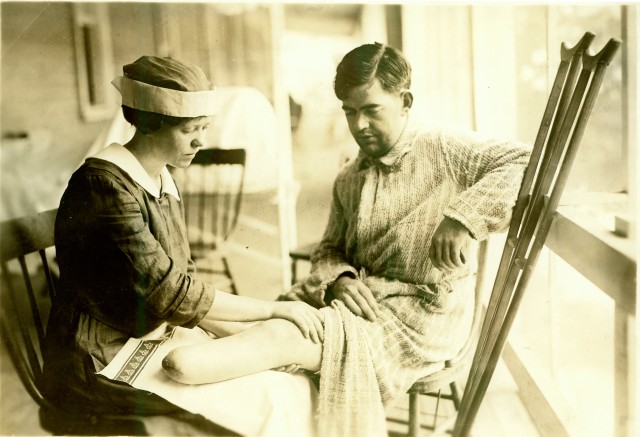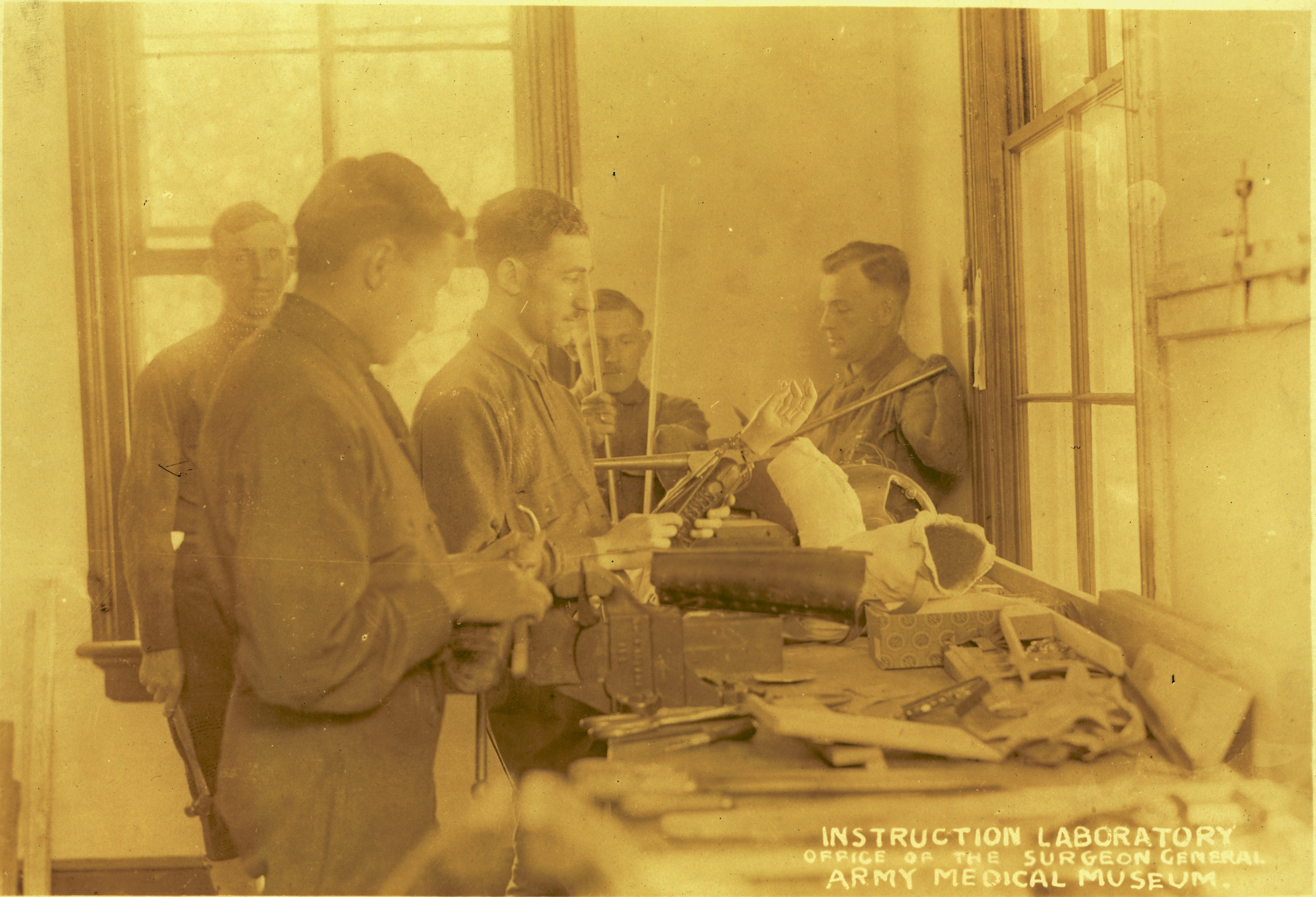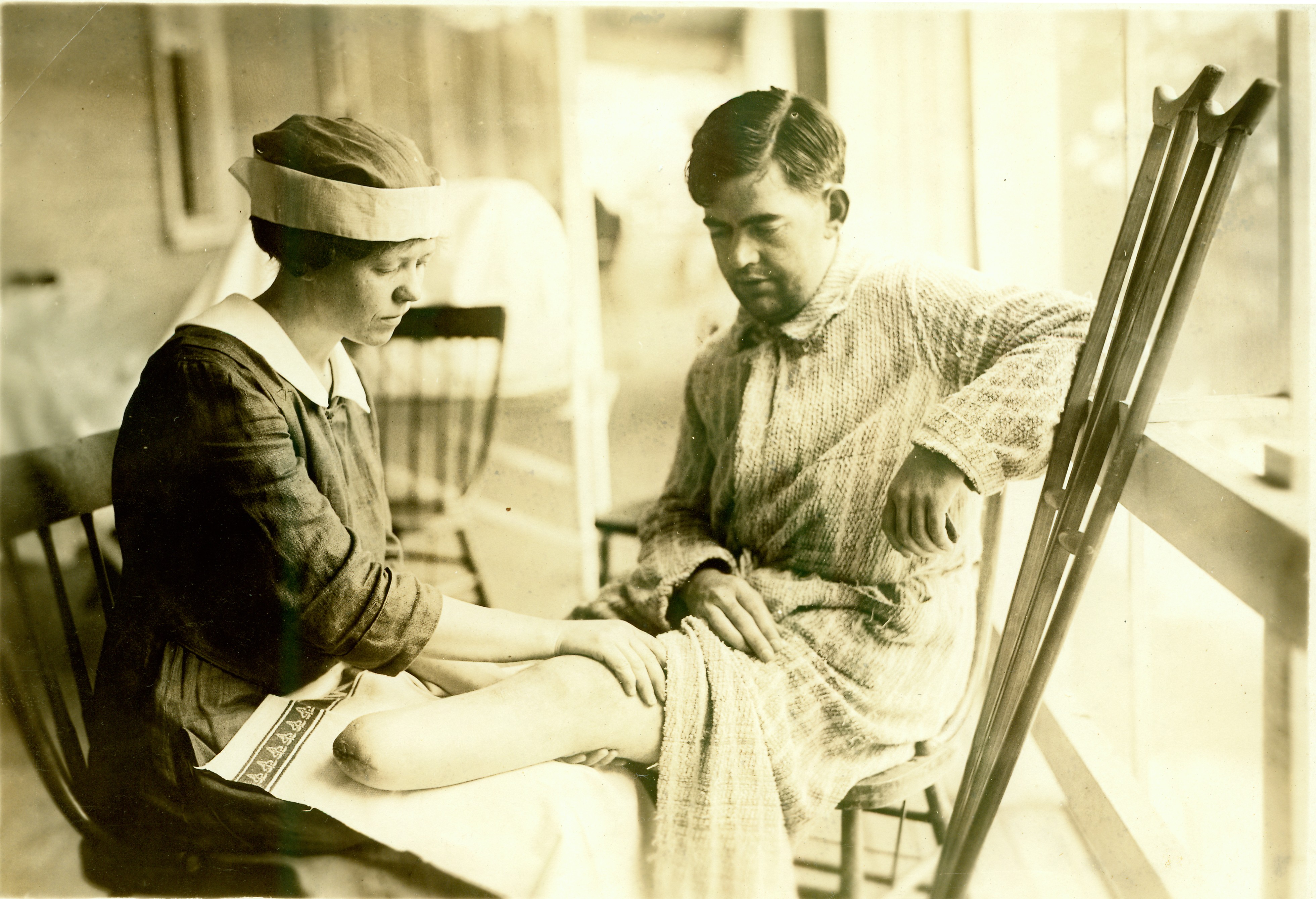He saw the improvised explosive device just before the explosion.
Staff Sgt. Brian Shar, a team leader on a convoy moving between bases near Baghdad, saw what looked "like a giant cartoon rock, about 18 inches wide, 11 inches tall."
The explosion removed both of Shar's legs above the knee, caused nerve damage in one arm and serious internal injures. Advances in battlefield medicine helped him survive, and 100 years of experience caring for wounded warriors helps Walter Reed Army Medical Center provide Shar and other patients with the best health care and rehabilitation technologies available.
WRAMC celebrates its 100th anniversary this month. From its start as an 80-bed hospital, Walter Reed has grown to a 247-bed medical center with 60 outpatient clinics and 16 operating rooms. It is the only Department of Defense medical-treatment facility with a clinic dedicated solely to wounded warriors and their families. As one of the world's premier military medical facilities, it combines patient care, teaching and research. For Soldiers like Shar, that expertise means the chance to walk again.
Shar arrived at Walter Reed Sept. 23, 2007, after being medically evacuated from Iraq via Landsthul Regional Medical Center in Germany. Wounds like his often require multiple surgeries, as doctors remove debris, bacteria and dead flesh in a life-or-death battle against infection. Shar endured several of these "wash-outs" and was released from in-patient care after about one month.
Soon after his initial release, he suffered a setback, when severe back pain led to a trip to the emergency room. He was informed by a staff member that his wheelchair was leaking. In fact, the pain came from fluid collecting in his back due to shrapnel wounds. The fluid was flowing out of a wound and dripping to the floor. He was rushed to surgery, where part of his colon was removed.
"They could have given me a colostomy bag and let my body heal, but they didn't," Shar said. "They removed the damaged organ tissue and hand-sewed me back together for six hours."
Shar spent another month as an in-patient recovering from his intestinal injuries, and was released in late November. His goal was to walk by Christmas. "They had me up and walking within three months of being injured, when I was only out of bed for one of those months. The treatment here is great."
Shar walks into the Walter Reed orthopedic clinic on prosthetics called C-Legs, fitted and fine-tuned. Daniel Carroll, a WRAMC-certified prostheticist, rotates the threaded post of a three-legged stand that looks like a miniature swivel stool. The platform rises and Shar rests the stump of his right leg on the stand.
They are in an examining room in the prosthetics lab, where fittings for artificial limbs are created and adjusted to give the patient optimal movement and comfort. Pairs of prosthetic legs lie abandoned in corners and against walls. The faint scent of plaster wafts in from the workshop next door. Shar and Carroll check the socket that connects the prosthetic to his thigh, looking for the place where adjustment is needed.
A C-leg is a prosthetic for above-the-knee amputees that combines microprocessors, sensors and hydraulics to allow amputees to walk. Carroll said the evolution in prosthetics that brought patients from wooden legs to the alloy prosthetics of today is due to new materials. For example, "carbon fiber as a material is flexible enough to duplicate ankle motion without bumpers and moving parts."
Carroll said older technology, like the Solid Ankle Cushioned Heel foot, could not store energy and help the patient walk. "When (the C-leg) is compressed and returns to its normal shape, it will give propulsion to hopefully duplicate some of the muscle activity the patient has lost."
The Military Advanced Training Center is a recent addition to Walter Reed. The 31,000 square-foot rehabilitation center opened in September 2007. It has cutting-edge technologies like computer and video monitoring systems and simulation rooms. There, servicemembers at different stages of recovery, most missing part of one or both legs, are learning to walk again.
Cristin Loeffler, a MATC physical therapist, ties an elastic band around Shar's thighs. He walks crab-like, holding onto the rail of the oval track that dominates the second floor of the $8.9 million facility. The bands increase the tension on the muscles around his hips. Shar takes a step with his left leg, the band stretches taut, then he closes the stride with his right.
After traveling halfway around the track, he switches directions and returns to the starting point, working out the opposite hip.
Shar says, "She works me hard."
They are working on his hip, thigh and gluteus muscles using an exercise called resisted abduction. "I waddle a lot, so we're trying to get the core muscles stronger," Shar explains. "I'm making a lot of progress, ever since I had (Loeffler) for a therapist. She's been busting me hard, so I'm doing a lot better."
Loeffler agrees Shar is making good progress. "I started working with him in July and he's gotten away from carrying a cane. He went from two canes, to one cane, to no cane."
After more exercises, Shar tells Loeffler he has to leave for an appointment with his primary care physician. Loeffler objects.
"I've got you five more minutes," she says.
"I'll come back," Shar promises.
Servicemembers injured before the days of infrared, camera-assisted motion analysis and treadmills that mimic uneven ground went through different methods of physical therapy.
Before World War II, amputees used an obstacle course, where patients were required to jump from box to box and climb clumsily over obstacles. It was eliminated once therapists found patients would see better results by receiving instructions and practice on everyday tasks they would face in civilian life.
"War changes everything in the military," said Sherman Fleek, WRAMC command historian. "The doctors realized we have to do more than just heal these guys. Let's give them a skill."
The new method focused on easy-walking gaits, balance, turns, sitting and picking up objects. The first step in the new three-step program required exercises in balance, climbing stairs, and 180-degree turns. The second practiced sitting, getting up, bending, walking around curves, and 45- and 90-degree turns. The final focused on polishing up to give the men smoothness of motion. They were taught to dance and practiced getting in and out of a mock streetcar built specially for their therapy.
"Advancements in (physical and occupational therapy) have been realized during and immediately after each major war of the 20th century," said Dr. Jeffrey S. Reznick, former senior curator of the National Museum of Health and Medicine and director of the Institute for the Study of Occupation and Health. "Fortunately or unfortunately-depending on one's point of view, of course-war can be 'good' for medicine in the sense that it pushes new innovation, and speeds innovation that might already be underway before a war begins."
Like prosthetics, the rehabilitation methods used with amputees are evolving, and Walter Reed continues to seek the best treatments and technologies for its patients.
The Warrior Clinic, with its Americans with Disabilities Act-compliant restrooms, doublewide doors and lower examining-room tables, was specifically designed for wounded warriors and their families. Its comfortable seating, warm amber lighting, and 50-inch flat-screen televisions invite relaxation.
Shar is here to see his primary care physician, Capt. Ingrid Pacowski. In the examining room, Pacowski calls up Shar's electronic medical record using the Armed Forces Health Longitudinal Technology Application. She goes through routine questions, asking about his recovery and looking for any new problems.
"Any allergies'"
"Yeah, I.E.D.s," he replies.
Pacowski is part of the Triad of Care, a concept initiated by the Army Medical Action Plan. It calls for a primary care physician; a nurse case manager, who handles the administration of their medical care; and a squad leader, who works with the chain-of-command to solve military issues.
"It's good for them to have a general doctor who can be like their family doc who then helps all the specialists, bringing all their care into one place," Pacowski said. "(They have) some place they can go to sick call; and a doctor they know they can bring their problems to."
Pacowski acts as a medical liaison, delivering medical information to the case manager and chain of command to avoid gaps in treatment.
"The Soldier is getting a comprehensive kind of care in all aspects of their lives," Pacowski said. "Their families are taken care of, their administrative and military stuff is taken care of, their medical side of the house is taken care of, and they've got a nurse case manager who's helping to bring all that stuff together."
The teamwork approach used today originated at the outbreak of World War I, when the resources of Walter Reed surgeons, prosthetists, nurses and therapists were consolidated, and patients were treated by a team to provide consistent and comprehensive treatment.
Large-scale combat led to a sharp increase in the number of Army nurses, and a new focus on patient rehabilitation and therapy. The growing need for specialized therapy led to the evolution of the Occupational Therapy and Physical Reconstruction departments at Walter Reed.
"The wounds they came back with, what we saw at Walter Reed, was a result of what happened in Europe. They were out to save lives, ensure survivability. The idea of how much of a limb or muscle mass to take wasn't realized," Fleek said. "In World War I we had a lot of amputees. It was like the opening of modern medicine."
Colonel Norvel Van Coots, commander of the Walter Reed Health Care System, said many of Walter Reed's recent improvements were brought on by Operations Enduring Freedom and Iraqi Freedom.
"Each of these improvements occurred because we rose to the challenge of sparing no expense (and) no effort in taking care of these deserving men and women," Coots said. "While each requires constant monitoring and effort to ensure we are meeting the needs of our warriors in transition, I believe these developments have made 'the Home of Warrior Care' a reality, and not just a slogan."
"Hundreds of thousands of people have passed through those gates and have been healed," Fleek added, "and not just the patients, the staff too... these guys are doctors and nurses because it's in their blood."
Craig Coleman and Kristin Ellis work at Walter Reed AMC public affairs.




Social Sharing